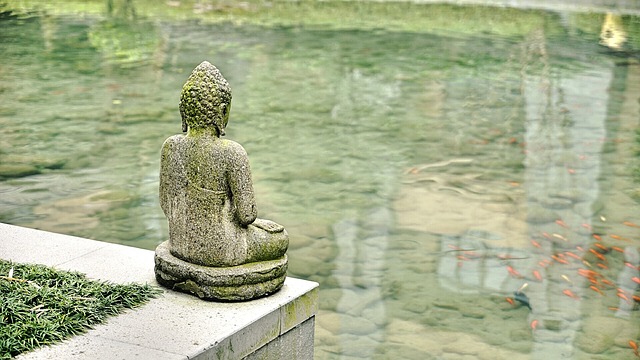by Laura K. Secor

Hello my friends,
Last month I gave you an outline of the Bodhisattva vow. I touched on the classic version, where the devout practitioner dedicates his life to the betterment of others. This in itself, the embodiment of compassion, is somewhat unbalanced to my Western mind. It ties us into the ethic of service that is inculcated in young girls, young women, young mothers. Is it any wonder so many of us come to menopause and say – why have I lived my life fully in service to others? What is compassion, standing on its own? Where is my core? Sometimes, in yoga, when I stand in a balancing pose, I feel that my center of gravity is about two feet away from me, in a line drawn out from my heart, about where another person would stand if I were offering them my support. I feel that my center has been given to others.
I learned from Tara Brach that some Mahayana Buddhists actually speak of the two wings of practice. The first wing is compassion, but the bird cannot fly with only one wing. The bird requires the second wing of “true seeing”, or wisdom. This gives a compassionate person her center. The center returns, as the third eye opens, and the compassionate person acts not from the place of a helpless compulsion to serve, but from a rich place of understanding. She understands human nature, but not just the nature of the other. She understands her own nature, her own place in the web. When she stands in mountain pose, she feels her center deep in her gut, she feels the line of energy from gut through heart to third eye. All are awake, all are aware.
That’s why I am drawn to Shantideva’s modification of the classic Mahayana Bodhisattva vow. He advises us to traverse the path of enlightenment on two tracks, like a train steadied by it’s placement on two rails. The rail of compassionate service is steadied by the rail of personal spiritual reflection and dedication to self-understanding.
There is a poet – I’ve introduced you to him in years past – who is my touchstone for clear seeing. Tomas Transtromer was a Swedish poet of the 20th century, and a Nobel laureate. His spirituality is Christian rather than Buddhist, but he has a devotion to the kind of vision encouraged by Shantideva – a wisdom that sees the many in the self, and the self in the many. He is not a humanist but someone who draws from the wisdom of the natural world. I offer you the very first poem he ever published.
Prelude
Waking up is a parachute jump from dreams.
Free of the suffocating turbulence, the traveler
Sinks towards the green zone of morning.
Things flare up. From the viewpoint of the quivering lark
He’s aware of the huge root systems of the trees,
Their swaying underground lamps. But above ground
There’s greenery – a tropical flood of it – with
Lifted arms, listening
To the beat of an invisible pump. And he
Sinks towards summer, is lowered
In its dazzling crater, down
Through shafts of green damp ages
Trembling under the sun’s turbine. Then it’s checked,
This straight down journey through the moment, and the wings spread
To the osprey’s repose above rushing waters.
The Bronze Age trumpet’s
Outlawed note
Hovers above the bottomless depths.
In day’s first hours, consciousness can grasp the world
As the hand grips a sun-warmed stone.
The traveler is standing under the tree. After
The crash through death’s turbulence, shall
A great light unfold above his head?
I come back to this poem often. I struggle with the different geographies he traverses, the underground globes of the forest root systems, the turbine of the sun, the rushing waters under the glide of the osprey. I haven’t quite visualized the wonderland he describes, but knowing that he sees it, and imagining it in glimpses, I feel a spiritual lift, the warm updraft supporting the bird’s two wings.
